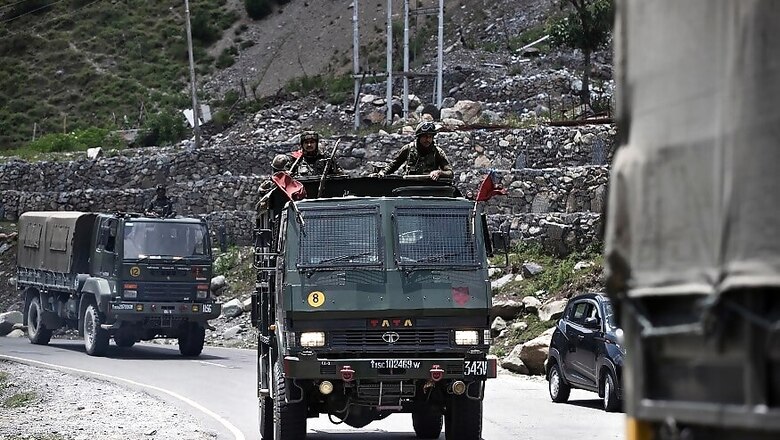
views
One thing is clear from the events of the past month, brought into sharp focus by the deaths in the Galwan Valley on the night of 15 June — this border crisis with China is different from anything in the past fifty years. The scale of this standoff and the PLA’s intransigence along the LAC suggest that China hopes to present a fait accompli in at least one of the three principal hotspots — Pangong Tso, Gogra and the Galwan Valley. Of these, the north bank of Pangong Tso is disputed territory, and has already been occupied by the PLA in unprecedented numbers, making it the likeliest candidate for a change in status quo. The Galwan Valley, site of the first Indian fatalities along the Chinese border since 1975, is also of particular significance since it dominates the vital road link to Daulat Beg Oldi. Despite two separate Corps Commander-level meetings between the Chinese and Indian sides, the latest imagery shows new Chinese infrastructure on the Indian side of the LAC.
What is not new, however, is the fact of China’s constant creeping encroachment along its entire border with India. Every crisis that periodically flares up begins with a Chinese provocation, yet here we are in 2020, again on the back foot. India and China have inked five Border Peace and Tranquillity Agreements since 1993 but these have not led to any mutual clarity on the boundary, nor done anything to dent Beijing’s enthusiasm for regular provocations in the north and east. Paradoxically, these agreements have made something of an obsession of the idea that no shots have been fired along the LAC in the ensuing years, this being presented as an illusion of effective diplomacy. But loss of lives and territorial sovereignty is not effective diplomacy. Restraint in firing should have been a means to an end — solving a border problem — but as with so many things in Delhi, activity quickly becomes a substitute for achievement.
This standoff should finally make clear to all arms of the Indian government that China is a revisionist power that does not deal with territorial disputes in good faith, firing or no firing. The constant scramble to react to Chinese ‘salami slicing’ on our frontiers shows that not enough attention is being paid, for example, to Beijing’s moves in the South China Sea — or the correct lessons are not being learned. Duplicity there has paid off handsomely, backed of course by the threat of hard power, and it stands to reason that China would be more than happy to try and replicate those gains elsewhere. Former US Secretary of Defence, James Mattis, then a Marine Corps Major General in the early days of the Iraq war, told his men to “be polite, be professional, but have a plan to kill everybody you meet.” This should always have been a guiding mantra dealing with China, and certainly must be moving forward. In more diplomatic terms that might go over better at the Ministry of External Affairs, “trust, but verify.”
New Delhi needs to wake up to the reality that China is not a narrow problem at the LAC, or Gwadar, or in our smartphones, or the TikTok videos we consume and create. It is a clear and present strategic competitor. China’s public pronouncements in response to, for instance, regional initiatives such as the Quadrilateral Security Dialogue (Quad), make clear that Beijing believes India is working to contain Chinese strategic ambitions. India’s muddled foreign and security policy is of course, doing no such thing, or is marked by a distinct lack of achievement on this front. If China continues to act based on its assumptions, however, India will need to start treating the problem with the seriousness it deserves. While regional and global alliances are well and good, policy schizophrenia on the home front needs to be sorted out first, and fast. No arm of the Indian State can be allowed to award contracts to Chinese companies (there is no such thing as ‘private enterprise’ in China) while the Indian Army loses lives to Chinese troops at 15,000 feet in the Himalayas. Beyond the obvious trade deficit, this will (and already has) created vulnerabilities in critical infrastructure sectors such as power generation/distribution, telecom and rail.
An all-of-government endeavour to deal with China, will certainly require military to curtail Chinese adventurism. But India’s military needs serious reform to keep pace with the country’s security challenges, particularly those posed by China. Peer states are not deterred by an archaic, over-elaborate, import-dependent military. Any adversary worth the name will endeavour to bring overwhelming force to bear over short time frames across narrow areas of action — and India’s ability to do the same is the only deterrent. Even if India is fated to remain reactionary, if her military response is slow in coming or under-sized in scale, it will accomplish little and deter less still.
The roadmap for military reform has to be part-parallel, part-sequential; part-procurement, part-investment. Long-term development programmes do compete for funding with immediate procurements, but this border standoff is living proof that crises do not allow you the luxury of getting your force structures in order over multiple decades.
Combat mass for the immediate future must be achieved through standardisation and domestic production of ordnance such as tank and howitzer rounds, small arms and ammunition, and air-launched guided weapons. The aim should be mass production in vast quantities through whatever means necessary — even if that means acquisition or licencing of foreign munitions to avoid needlessly re-inventing the wheel. State-run Ordnance Factories struggling to make reliable shells for Army guns should never have been acceptable, and certainly cannot counter China’s military-industrial complex.
Meanwhile the development side has to be streamlined so it is not spread thin over a multitude of programmes that then crawl forward, often only in fits and starts. The Defence Ministry must decide, without parochialism, on a handful of critical and realistic programmes that must be developed in-house. The remaining capability gaps should be filled through procurements at the most commercially viable terms. The propensity to increase the cost of imports, which are often critically required, by front-loading deals with offsets, technology transfer, local production and the like has not served any military or industrial goals. If indigenous research, development and production is pursued in a sustainable manner, there will be no reason to burden already-expensive imports with additional costs that end up buying little of any value.
Finally, enough has been written and said on the dire need to reform military manpower and drive personnel costs down to rebalance defence spending, but this is a point that bears repeating simply because of how acute the problem has now become.
Military planning, training, acquisition, cannot be stuck in endless loops driven by promotion cycles and retirement schedules, and certainly should not be hostage to ‘musical chairs’ at the defence minister’s post. China looked at what India had arrayed against it in the forbidding Himalayan frontier and nevertheless elected to come a-knocking. The Indian Army may have answered bravely, as it is so often called to do, but it is worth asking how China came to choose this course of action and what that says about us.
This article was first published on ORF.




















Comments
0 comment